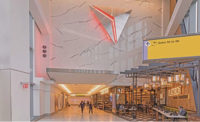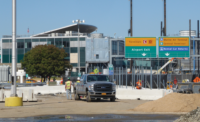Call it recycling on a whole new level at San Francisco International Airport: The $380-million Terminal 2 project features 99% recycling of construction materials.
Airport tenants also need to meet a 10% waste recycling minimum. Rental-car drivers will get discounts for using hybrids. Even the landscaping is an exercise in sustainable approaches to harboring protected species.
“We use goats,” says Sam Mehta, environmental services manager for SFO. “It is 100% sustainable. The grass is eaten and fertilized. For them, it’s an all-you-can-eat buffet, and they don’t harm the California red lake frog and San Francisco garter snake. The cut grass reduces the chance of summer fires.”
Mehta shared these and other sustainable practices at the Airports Going Green conference in Chicago, held on Nov. 15-17. There, U.S. Dept. of Transportation Secretary Ray LaHood helped unveil version two of the Sustainable Airport Manual (SAM) to over 300 airport industry officials in attendance, many from around the globe. The document evolved from the Chicago Dept. of Aviation’s “Sustainable Design Manual” (SDM), which officials began using in 2006 to rate modernization projects. The latest SAM (version 2.0) expands checklists for designers and contractors to include airport planning, maintenance and operations as well as concessions and tenants.
The 690-page SAM, distributed to attendees on portable USB storage drives in a bid to save paper, represents emerging best practices in sustainable design gleaned from airports throughout the country. “We want to learn from the knowledge and experiences of American airports,” said Dengxiang Shao, assistant general manager with Beijing Capital International Airport, which is planning a new terminal.
Over the past few years, officials said, more often than not, sustainable practices save money. But considering the return on the up-front investment is always an issue, especially when trying more expensive measures like solar panels and photovoltaic cells. For instance, Portland International Jetport in Maine installed LED lights in a parking garage, expecting to save $7,000 a month with an expected return on the investment of 18 months, said the airport’s deputy director, Roy Williams. But the ROI on replacing parking-lot lights would be 12 years, and the lights would last only 15 years, he added.
The Federal Aviation Administration is trying to help airports adopt more methods in sustainability. LaHood told conference-goers that the Voluntary Airport Low Emissions Program (VALE) has so far doled out $85 million in grants to 22 airports since it began. A recently launched two-year Sustainable Master Plan Pilot Program has funded long-range planning documents at 10 airports that will include initiatives for reducing environmental impacts and achieving economic benefits. Results of the program will be used to develop national program guidance on airport sustainability. Ithaca Tompkins Regional Airport in New York state will use its sustainable master-plan grant to map out its baselines and benchmarks; the airport is expected to involve students at local colleges in some of the work, said Robert Nicholas, the airport’s director.
Portland’s jetport used a $2.37-million VALE grant to build a $3-million geothermal system plant that would not have had a good ROI otherwise, said Williams. The system of 120 500-ft-deep wells, including 66,000 in. of pipe, is expected to reduce annual emissions by a ton and save $195,000 a year in fuel savings, adds Jim Stanislaski, senior architect with Gensler, San Francisco.
The SAM is recommended for use in conjunction with a planned Transportation Research Board study (ACRP-02-28) for which a request for proposals was released last month, said Jim Crites, executive vice president for operations of Dallas/Fort Worth International Airport and the head of the SAM committee on planning. The 18-month, $600,000 study would help airports to choose best practices, develop a prototype sustainability rating system and evaluate the viability of implementing the rating system as well as an associated voluntary airport sustainability certification program, according to the TRB.
“How do we recognize [sustainability practices] beyond LEED?” said Crites. “ACRP-02-28 is about using SAM in a research [function] to build that recognition capability.”
Best practices don’t always have to be high-tech, officials stressed. As the new chapters on operations and tenants and concessions highlight, airport operators simply can work on reducing the existing footprint’s impact. “You don’t need a capital program to begin sustainability,” noted Crites. For instance, San Diego International Airport saved $35,000 last year by reclaiming waste materials and selling them, said Paul Manasjan, the airport’s director of environmental affairs.
At SFO, in addition to employing goats as landscapers, the airport is incorporating operational requirements for its Terminal 2 expansion that helped earned it the title of being the first LEED Gold-certified airport terminal in the U.S. Slated to open in April 2011, the 640,000-square-foot terminal will include a 10% recycling minimum for tenants, a number of vegetarian and cruelty-free food options, low-flow faucets, water stations in lieu of water bottles and a green rental-car program that rewards drivers for using hybrid cars, said Mehta.
O’Hare’s ‘Project Runways’
During his comments at the conference, LaHood hailed Chicago’s O’Hare International Airport as “one of the greenest airports in the country.” Shortly thereafter, he announced that the Federal Aviation Administration will commit $3.4 million to the design and construction of a new South Air Traffic Control Tower at Chicago’s O’Hare Airport, scheduled to be built as part of the $6.6-billion O’Hare Modernization Program (OMP).
That tower will be LEED-certified, as was the new 255-ft-high tower completed in 2008 as part of the OMP’s nearly completed phase one. Along with a new 7,500-ft-long runway and a 3,000-ft-long runway extension, construction of the tower benefited from sustainability practices. “All came in $40 million under budget, while being green,” said Rosie Andolino, Chicago aviation commissioner. She claimed the airport has saved $120 million so far just by stockpiling all earthwork on-site for reuse or capping. Approximately 95% of all construction-demolition materials on the OMP is reused on-site and diverted from landfills, saving over 70,000 tons of CO?. The airport along with Midway Airport now has 230,000 sq ft of green roofs, including a 3.5-acre roof on a FedEx cargo facility that will open in 2011. Another 162,000 sq ft of green roof is under design.
Crews have crushed 250,000 tons of materials for reuse and used 160,000 tons of recycled concrete as base material for the runway shoulders, says Khaled Naja, the Chicago Dept. of Aviation chief operating officer. Some 18 million cu yd of materials have been handled so far and are kept on-site. “We’re improving the airfield with exactly what we have,” says Naja. “It’s a zero-sum game.” The airport even has a special drop-off area to accept and reuse materials discarded from other projects. Recently, it received 80,000 cu yd of asphalt grindings from a nearby road project. The massive stockpiles of materials, squeezed into an active airfield with non-stop construction, are seeded to resist erosion.
The OMP requires ultra-low-sulfur diesel in all construction equipment. Andolino said that over 90% of imported construction materials come from regional and local sources. “We are replacing 154 acres of low-quality, inaccessible wetlands on airport property with nearly 450 acres of higher-quality wetlands within various locations in northeastern Illinois, at a cost of more than $44 million—at no cost to taxpayers,” she added.
The Chicago aviation department also has a Sustainability Evaluation and Recommendation Team (SERT)—composed of CDA staff and environmental consultants—which is dedicated to discovering and recommending new sustainability initiatives and ideas. SERT is reviewing options for composting coffee grounds and other food waste from terminal concessionaires, identifying potential sites for solar panel arrays on airport property and investigating options for establishing electric vehicle charging stations and other clean-energy fueling stations.
The $3.2-billion phase one of the OMP will end with commissioning of a new runway scheduled for October 2013. Design work is under way for two new runways in the completion phase, one 7,500 ft long and the other 11,245 ft long. Another 3,500-ft extension will lengthen another runway to 11,260 ft. All three runway projects are scheduled for commissioning in 2015.










Post a comment to this article
Report Abusive Comment